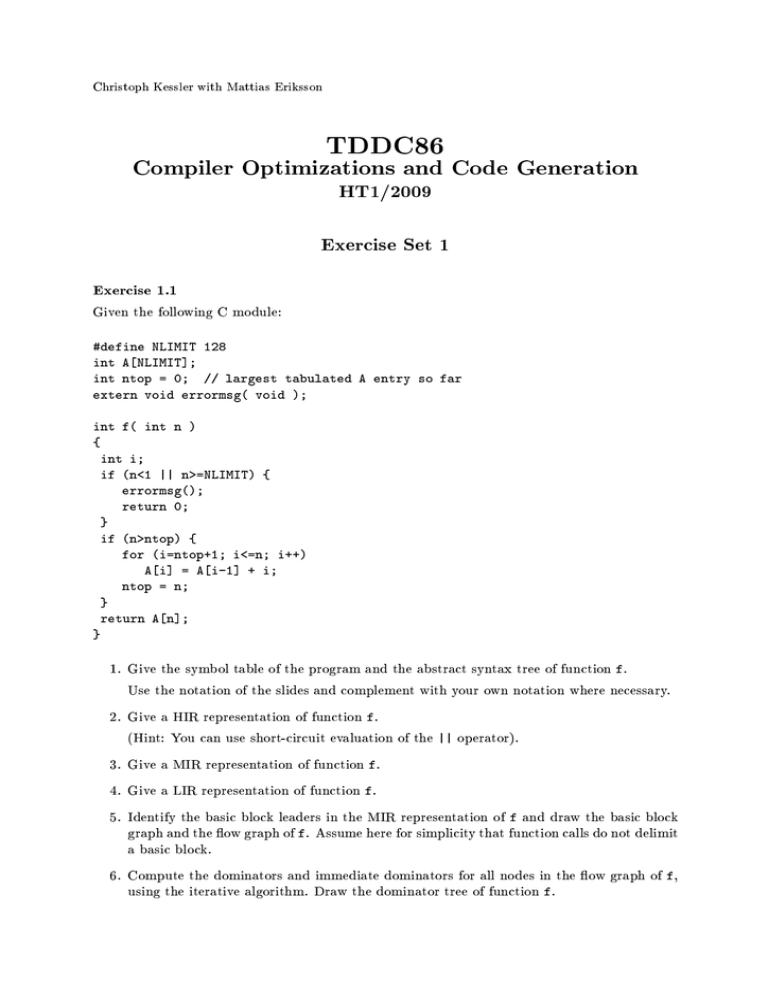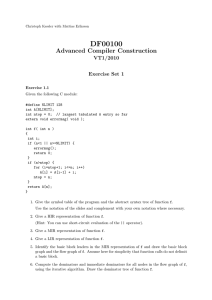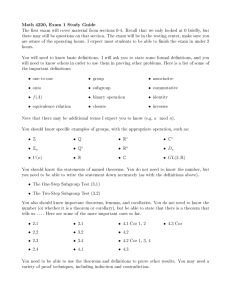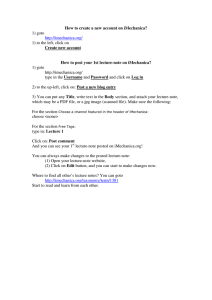Compiler Optimizations and Code Generation Given the following C module:
advertisement

Christoph Kessler with Mattias Eriksson
TDDC86
Compiler Optimizations and Code Generation
HT1/2009
Exercise Set 1
Exercise 1.1
Given the following C module:
#define NLIMIT 128
int ANLIMIT]
int ntop = 0 // largest tabulated A entry so far
extern void errormsg( void )
int f( int n )
{
int i
if (n<1 || n>=NLIMIT) {
errormsg()
return 0
}
if (n>ntop) {
for (i=ntop+1 i<=n i++)
Ai] = Ai-1] + i
ntop = n
}
return An]
}
1. Give the symbol table of the program and the abstract syntax tree of function f.
Use the notation of the slides and complement with your own notation where necessary.
2. Give a HIR representation of function f.
(Hint: You can use short-circuit evaluation of the || operator).
3. Give a MIR representation of function f.
4. Give a LIR representation of function f.
5. Identify the basic block leaders in the MIR representation of f and draw the basic block
graph and the ow graph of f. Assume here for simplicity that function calls do not delimit
a basic block.
6. Compute the dominators and immediate dominators for all nodes in the ow graph of f,
using the iterative algorithm. Draw the dominator tree of function f.
Exercise 1.2
Given the following basic block in MIR code:
c
b
b
d
a
d
c
a
a
2
b
c
b
b
a
2
+ 1
* a
+ c
/
/
*
d
c
b
a
Perform local common subexpression elimination to obtain a DAG representation of the code.
Exercise 1.3
We visualized the dominance relation on the slides with the light ow analogy. What would be
the corresponding setup for the postdominance relation?
Recall that the postdominance relation is dened as follows:
p postdominates b (p pdom b) if every possible execution path b ! exit includes p.
Exercise 1.4
Given the following MIR code
i From
s 0
t0 ( From To)
if not t0 goto L0
L1: t1 = i Int Size
t2 A + t1
t3 t2] (memory read)
t4 (a < 0)
if t4 goto L2
t5 a 0:8
t6 s + t5
s
t6
goto L3
a 0:8
t8 s ; t7
s t8
L3: t9 i Int Size
t10 E + t7
t10 ] s (memory write)
t11 i + 1
i t11
t12 (i To)
if t12 goto L1
L0: return s
L2: t7
1. Draw the control ow graph, nd the basic block leaders, and draw the basic block graph
and the ow graph.
2. Compute the dominators of all nodes in the ow graph using the iterative algorithm.
3.
4.
5.
6.
7.
8.
9.
10.
Compute the immediate dominators and draw the dominator tree.
Do a DFS traversal of the ow graph, starting with the entry node, and label the edges
with T, F, B and C.
Identify strongly connected components and natural loops in the code. Is the ow graph
reducible? If yes, draw the region hierarchy graph, following the structural analysis transformations suggested in the lecture on control ow analysis.
Give names to the variable denitions and expressions that occur in the code Example:
d1 denotes the rst assignment to i, and e1 denotes the comparison (FromTo)].
Formulate the ow functions and the data
ow equations for the Available Expressions
problem for each basic block.
Give a trivial, but correct solution to the Available Expressions problem.
Determine a xed-point solution of the Available Expressions problem with the worklist
algorithm. Explain whether your solution is a maximal safe solution or not.
Formulate the ow functions and the data
ow equations for the Reaching Denitions
(May-Reach) problem for each basic block.
Give a trivial, but correct solution to the Reaching Denitions problem.
Determine a xed-point solution of the Reaching Denitions problem with the worklist
algorithm. Explain whether your solution is a maximal (in the information-theoretic, not
set-theoretic sense) safe solution or not.
Please prepare these exercises for the rst lesson on 11 sept. 2009.







